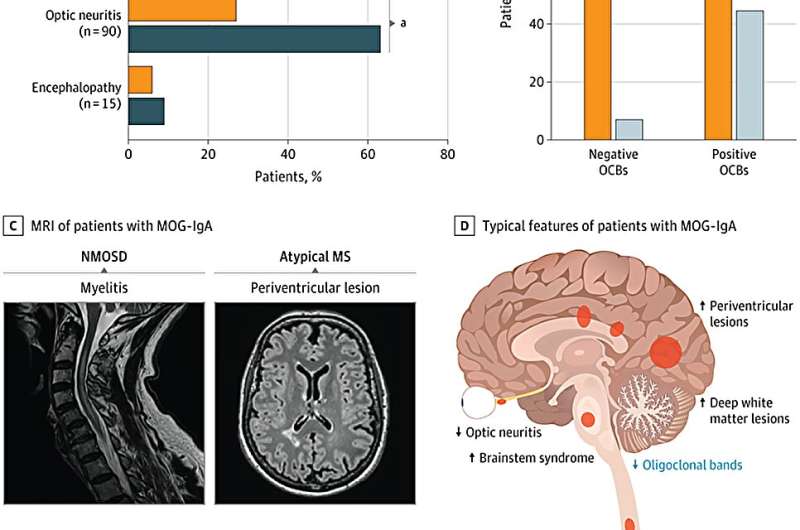This article has been reviewed according to Science X's editorial process and policies. Editors have highlighted the following attributes while ensuring the content's credibility:
fact-checked
peer-reviewed publication
trusted source
proofread
Possible biomarker of MS-like autoimmune disease discovered

It has been known for several years that the diagnosis "multiple sclerosis" conceals a whole range of different illnesses, each requiring customized treatment. Researchers at the University of Basel and the University Hospital of Basel have now described a possible new MS-like disease and explained how to diagnose it.
Multiple sclerosis (MS) is characterized by areas of inflammation in the central nervous system. The immune system attacks the body's own structures and destroys the covering of nerve cells, known as the myelin sheath. The picture research has painted of the illness is somewhat more complicated, however. It can cause a variety of neurological symptoms, like paresthesia and paralysis of the limbs, which progressively or abruptly worsen. Which parts of the nervous system are affected varies substantially between individuals.
A treatment may work for some patients—but make the condition worse in others.
"There's a huge amount of diversity in how inflammatory autoimmune diseases of the central nervous system like multiple sclerosis present," explains Professor Anne-Katrin Pröbstel of the University of Basel and University Hospital Basel. Researchers have been gradually discovering the key distinctive features of "atypical" cases of MS for the past ten years.
A few of these autoimmune diseases have been given different names to better distinguish them from MS even though they also destroy the myelin sheath. Victims of these diseases often have inflammation in their spinal cords or optic nerves.
In a study of roughly 1,300 patients, Pröbstel's team has now discovered a biomarker that may make it possible to differentiate another MS-like illness from the others. The researchers have reported their findings in the journal JAMA Neurology.
Antibodies as biomarkers
The team discovered a specific antibody, a type of immunoglobulin A (IgA), in one group of patients. The antibody attacks a component of the myelin sheath called "MOG" (which stands for "myelin oligodendrocyte glycoprotein"). IgA antibodies are typically responsible for protecting mucous membranes.
The precise role of MOG-IgA in this autoimmune disease remains unclear, however. "Victims experience inflammation particularly in their spinal cords and brain stems," Pröbstel explains. This group of patients was missing other typical biomarkers related to MS or similar diseases.
Next, the researchers want to decipher the role of MOG-IgA and the clinical characteristics arising from it in more detail. "By distinguishing between myelin-destroying autoimmune diseases that were previously all called MS, we're taking an important step towards a better understanding of the causes of these illnesses and towards individualized treatments," says the neurologist. Ultimately, the researchers hope to discover what treatments are most effective under what conditions.
More information: Ana Beatriz Ayroza Galvão Ribeiro Gomes et al, Immunoglobulin A Antibodies Against Myelin Oligodendrocyte Glycoprotein in a Subgroup of Patients With Central Nervous System Demyelination, JAMA Neurology (2023). DOI: 10.1001/jamaneurol.2023.2523



















